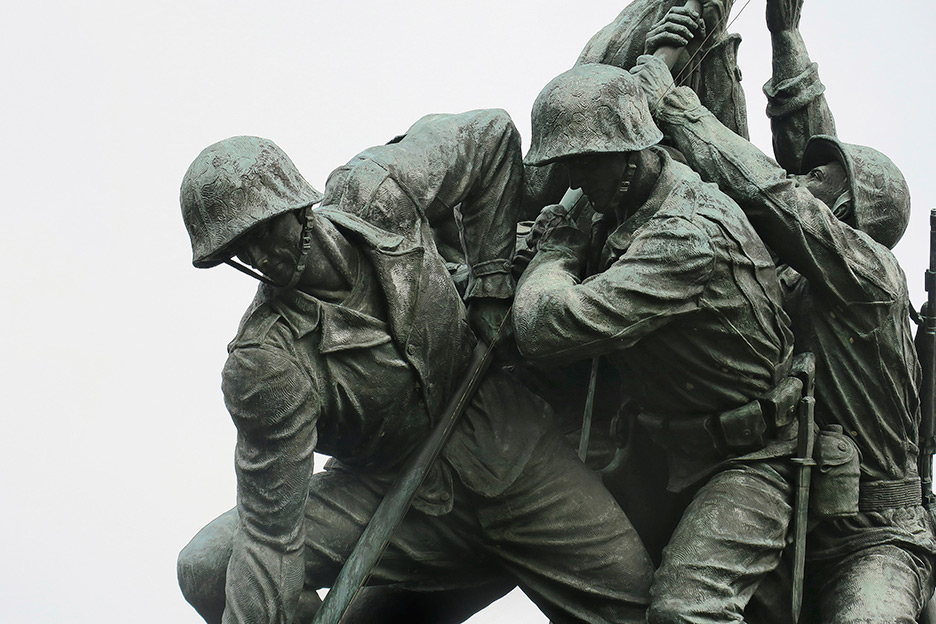
Iwo Jima Memorial
As we took off for the 10th Honor Flight full of 60 veterans, I was wondering how on earth we were going to be able to see WWII, Korean War, Vietnam, Iraq, Afghanistan, Arlington, Tomb of the Unknown Soldier, Naval Monument and the Air Force monument war memorials in less than three full days. The Honor Flight Team was a well oiled machine after 10 years operating the tours to Washington, DC. They had seen everything in taking the 70 and 80 year old warriors many with major health issues to see the country’s cherished monuments, which is why all the veterans had an assigned guardian. As a guardian, my job was to keep track of all the meds, restroom issues, oxygen levels for those who needed it and be wheelchair pushers. In my case, add documentarian. I got pretty good and taking videos while pushing the transfer type of wheelchair – the ones with the tiny front AND back wheels! Taking photos was more challenging, however because I had to be very close to dad – the Team did not like unattended vets. They had too many wandering off or getting lost in the past.
The second day of the tour was the ambitious to say the least. We were scheduled to see the Iwo Jima, WWII Memorials, The Air & Space Museum, Korean and Vietnam Memorials. By virtue of an ‘enthusiastic’ police escort the entire way, amazingly we made them all.
Our first stop was the Iwo Jima Monument. The first view of a major installation is almost always a surprise at the scale and power the monument possesses and this was was no exception. This massive iconic sculpture feels as if these gargantuan men are in motion and the flag will go completely vertical at any moment. One fascinating feature at the monument are the hands – so central to it’s meaning. The hand of the first soldier burying the flag into the soil with the full force of those behind him and all the other hands grappling with the flagpole trying to bury the flag deep into the rocky terrain on top of Mount Suribachi. The raising of the flag signaled the end of the fighting over this critically strategic island of Iwo Jima.
I found this great summation of the events and making of the statue from the National Park Service:
The tiny island of Iwo Jima lies 660 miles south of Tokyo. Mount Suribachi, an extinct volcano that forms the narrow southern tip of the island, rises 550 feet to dominate the ocean around it. US troops had recaptured most of the other islands in the Pacific Ocean that the Japanese had taken in 1941 and 1942. In 1945 Iwo Jima became a primary objective in American plans to bring the Pacific campaign to a successful conclusion.
On the morning of February 19, 1945, the 4th and 5th Marine Divisions invaded Iwo Jima after an ineffective 72-hour bombardment. The 28th Regiment of the 5th Division, was ordered to capture Mount Suribachi. They reached the base of the mountain on the afternoon of February 21 and, by nightfall the next day, had almost completely surrounded it. On the morning of February 23, Marines of Company E, 2nd Battalion, started the tortuous climb up the rough terrain to the top. At about 10:30 am men all over the island were thrilled by the sight of a small American flag flying from atop Mount Suribachi. That afternoon, when the slopes were clear of enemy resistance, a second, larger flag was raised in the same location.
Making of a Memorial
Joe Rosenthal of the Associated Press caught the afternoon flag-raising in an iconic photograph that eventually won a Pulitzer Prize. Sculptor Felix W. de Weldon, then on duty with the US Navy, was so moved by the image that he constructed first a scale model and then a life-size model of it. Gagnon, Hayes, and Bradley, the three survivors of the flag raising (the others were killed on Iwo Jima), posed for the sculptor as he modeled their faces in clay. All available pictures and physical statistics of the three who had given their lives were collected and then used in the modeling of their faces.
Once the statue was completed in plaster, it was carefully disassembled and trucked to Brooklyn, N.Y., for casting in bronze. The casting process, which required the work of experienced artisans, took nearly 3 years. After the parts had been cast, cleaned, finished, and chased, they were reassembled into approximately a dozen pieces–the largest weighing more than 20 tons–and brought back to Washington, D.C., by a three-truck convoy. Here they were bolted and welded together, and the statue was treated with preservatives.
President Dwight D. Eisenhower dedicated the memorial in a ceremony on November 10, 1954, the 179th anniversary of the U.S. Marine Corps.
Thirty-two foot high figures are shown raising a 60-foot bronze flagpole. The flag at the top of the pole flies at full mast 24 hours a day, 365 days a year by presidential proclamation.
The figures in the statue occupy the same positions as in Rosenthal’s historic photograph. Ira Hayes is the figure farthest from the flagpole with both hands reaching up. Franklin Sousley is in front of Hayes, to the right. John Bradley is in front of Sousley. Michael Strank is in front of Hayes, to the left. Rene Gagnon is in front of Strank. Harlon Block is at the foot of the flagpole.
The M-l rifle and the carbine carried by two of the figures are 16 and 12 feet long, respectively. The canteen would hold 32 quarts of water.
The figures stand on a rock slope above a granite base. The entire memorial is about 78 feet tall. Granite for the base came from Sweden. The names and dates of every principal Marine Corps engagement since the founding of the Corps form a gold ring around the base.
The entire cost of the statue ($850,000) was donated by US Marines, friends of the Marine Corps, and members of the Naval Service. No public funds were used for this memorial.
That last part was pretty impressive in this day and age – No public funds were used.
The second stop was the World War II Memorial.
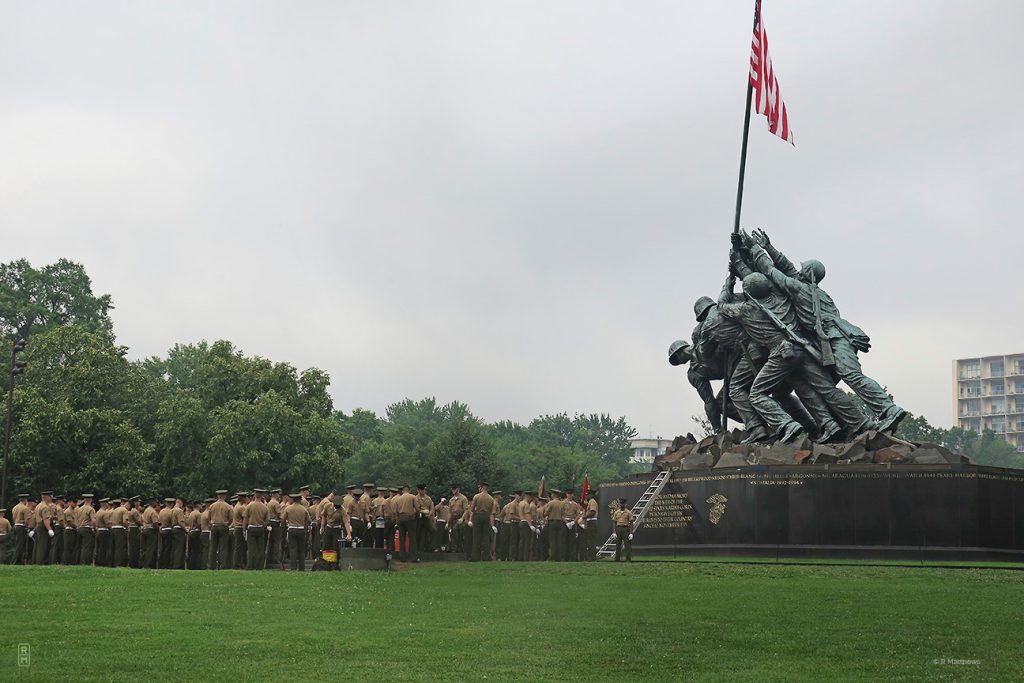
Marine Corp Color Guard at the base of Iwo Jima Statue
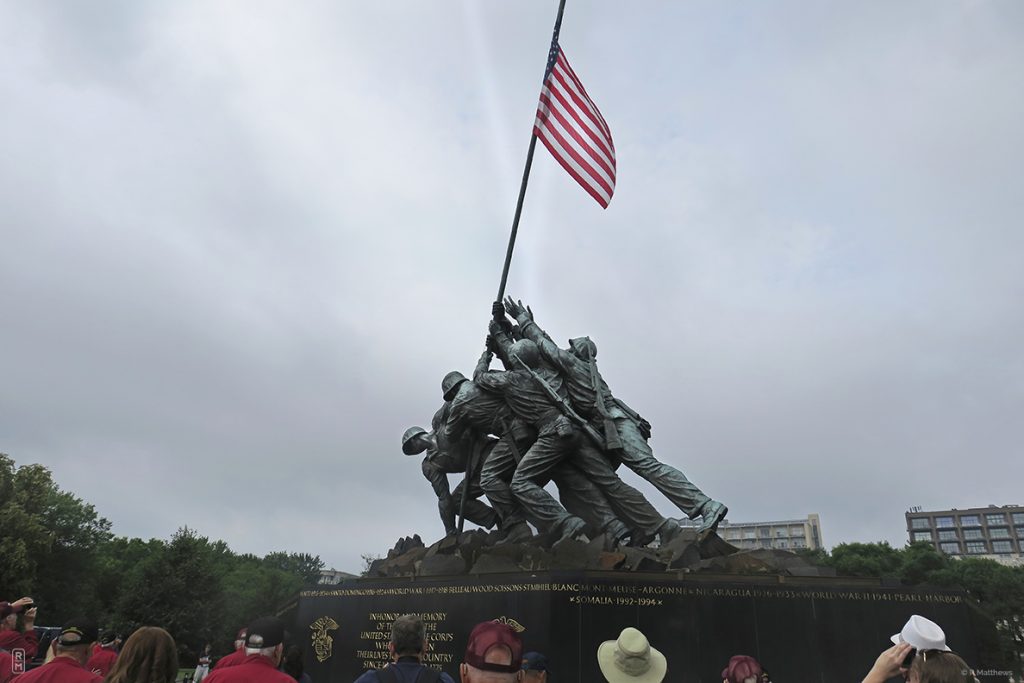
The signature outstretched reaching hands
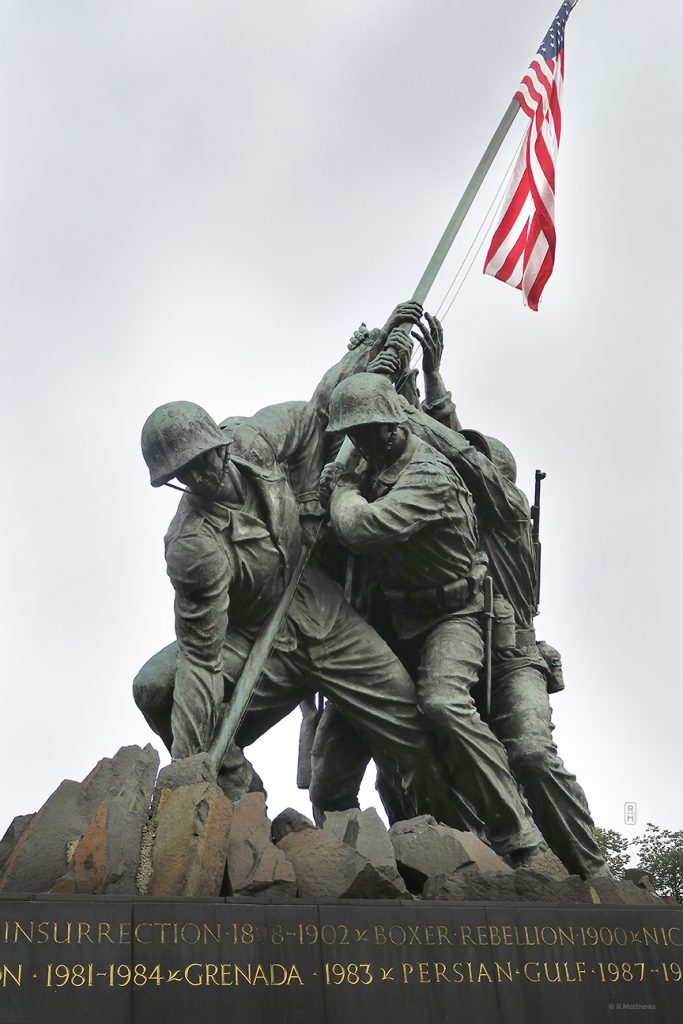
Plunging the flag in the rocky terrain of Mount Suribachi
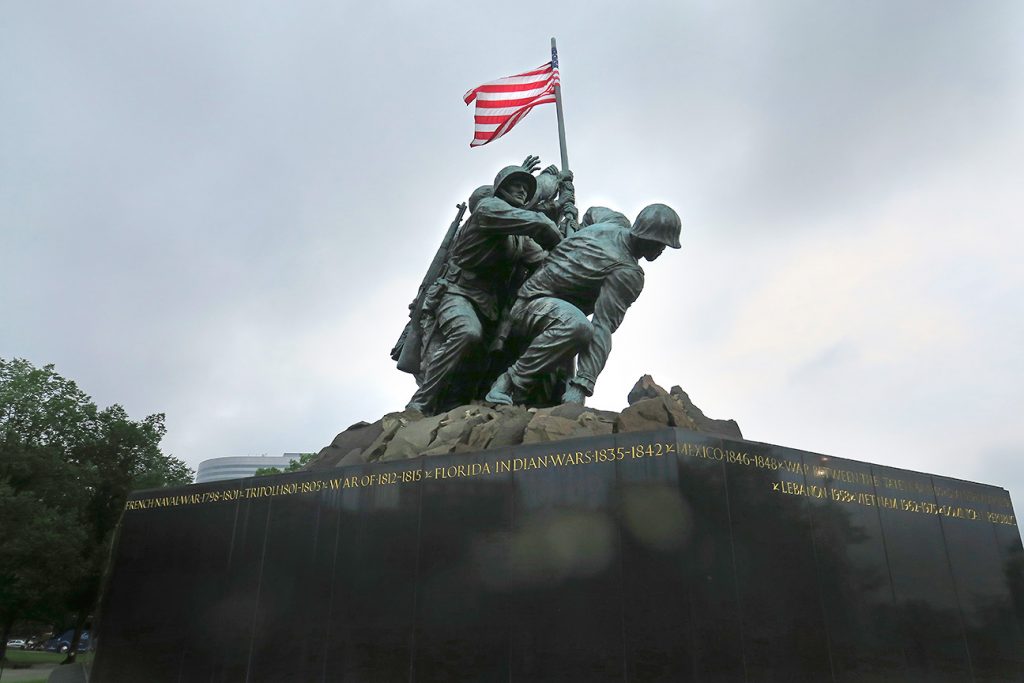
The backside is a unique view not usually seen in photos

World War II Monument in panorama
Here We Mark The Price of Freedom
Wide open in it’s architecture, The WWII Memorial is bordered on 2 sides each with 28 separate Granite columns – one for each state of the union plus territories and the District of Columbia. The two sides are divided by the Atlantic and the Pacific halves of the country. We walked into the Pacific Tower – a gateway to the inner courtyard and followed the gentle angled slope in front of the columns leading to the ground level. The gateway featured a beautifully detailed suspended bronze sculpture of eagles clutching a large wreath. Each column has a bronze wreath with the state etched into the granite. Once on the ground, the first thing you notice is the huge pool and fountain in perfect line with the Lincoln Memorial and the Washington Monument.
The next thing you notice are the inspiring fountains in front of the Atlantic and Pacific gateways – sculpted waterfalls combined with the flattened spray fountains facing inward with the heavy reflections etched into the walls – “They had no right to win. Yet, they did, and in so doing they changed the course of a war…even against the greatest of odds, there is something in the human spirit – a magic blend of skill, faith and valor – that can lift men from certain defeat to incredible victory. Battle of Midway June 4-7, 1942.” Walter Lord, author. On the opposite side of the fountain is this, “The Wars End. Today the guns are silent. A great tragedy has ended. A great victory has been won. The skies no longer rain death – the seas bear only commerce – Men everywhere walk upright in the sunlight. The entire world is quietly at peace.” General Douglas McArthur.
There are more quotes etched onto the wall, each one powerful in it’s own way. Many of the vets were in a very reflective mood and somewhat overwhelmed by the memorial, but seemed as if they felt recognized for what they had been involved with so long ago. After all this place was built for them.
The memorial gets over 4.4 million visitors each year honoring and remembering the sacrifices to those who kept the country free from tyranny.
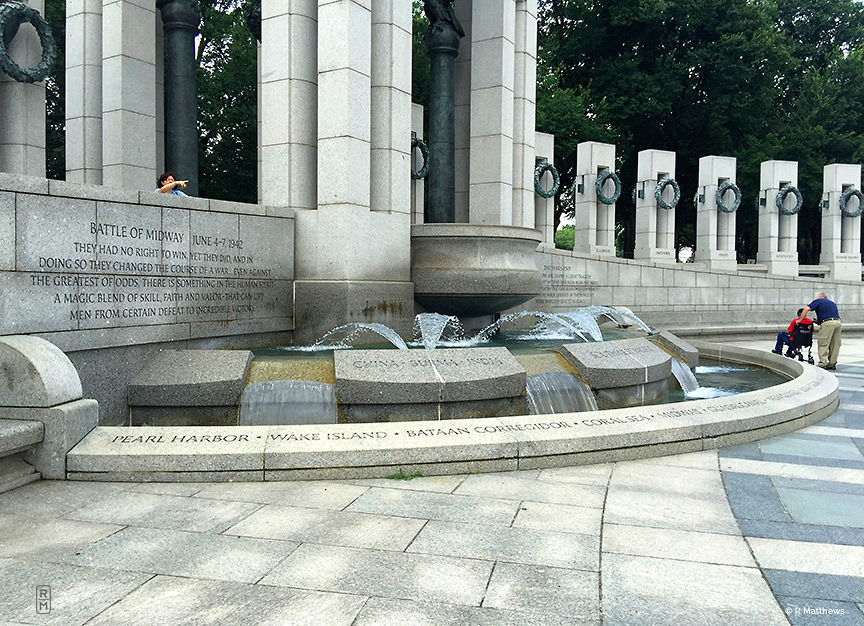
Battle of Midway remembered
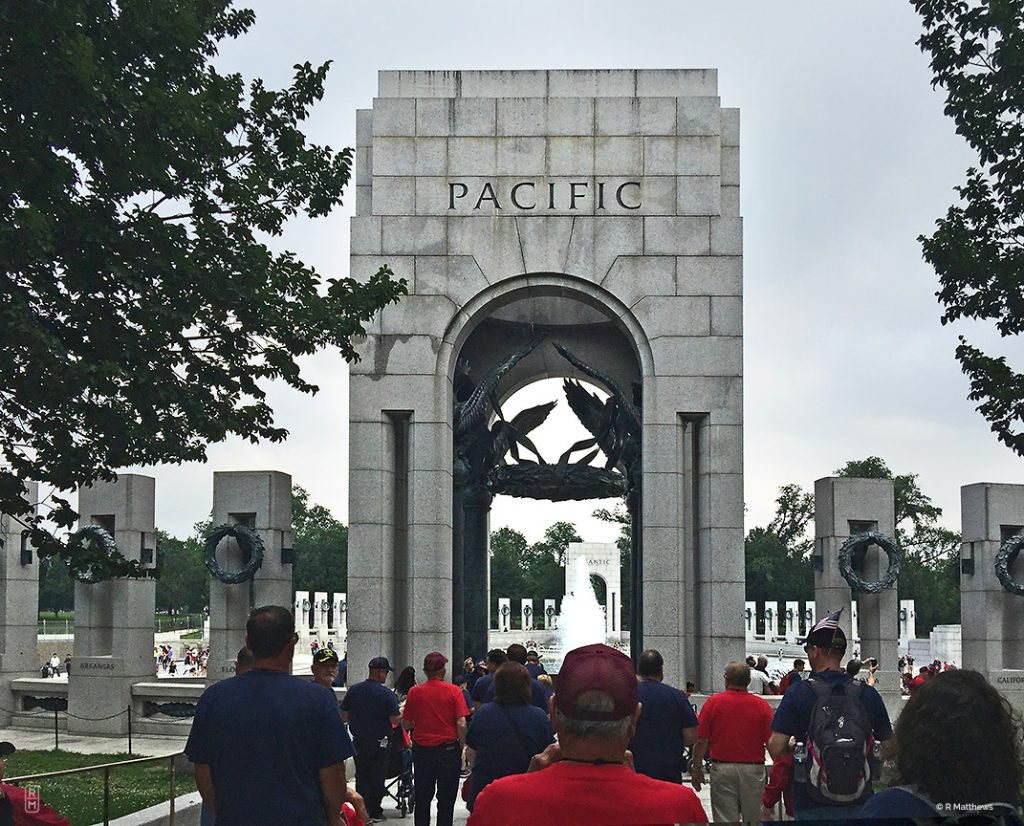
Pacific Tower entrance
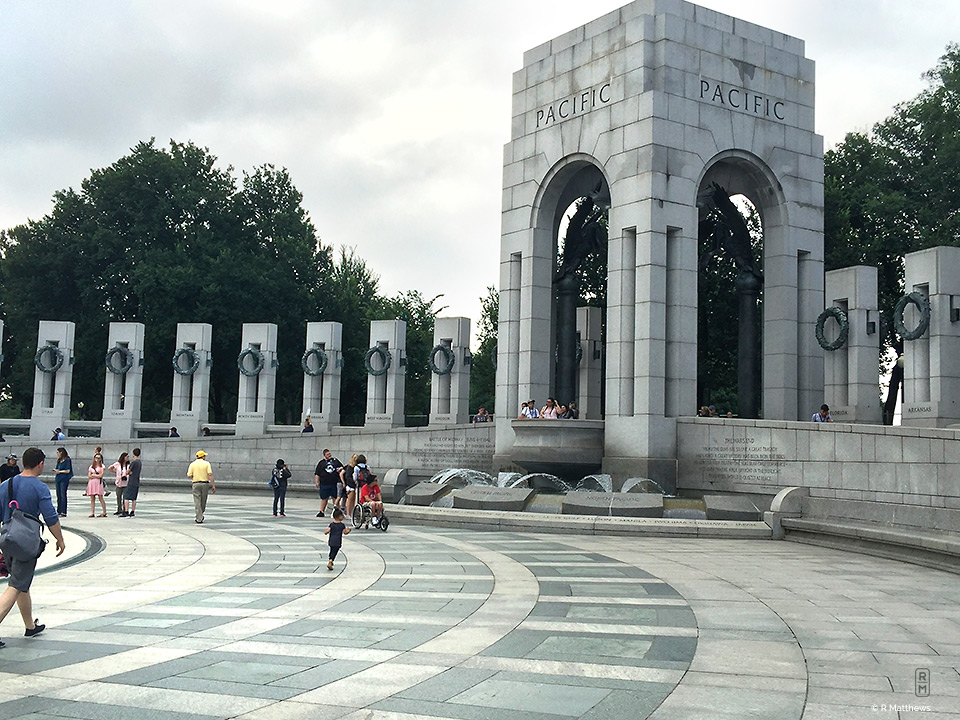
Inside the mall looking at the Pacific entrance
Memorial Plaza Navy Memorial
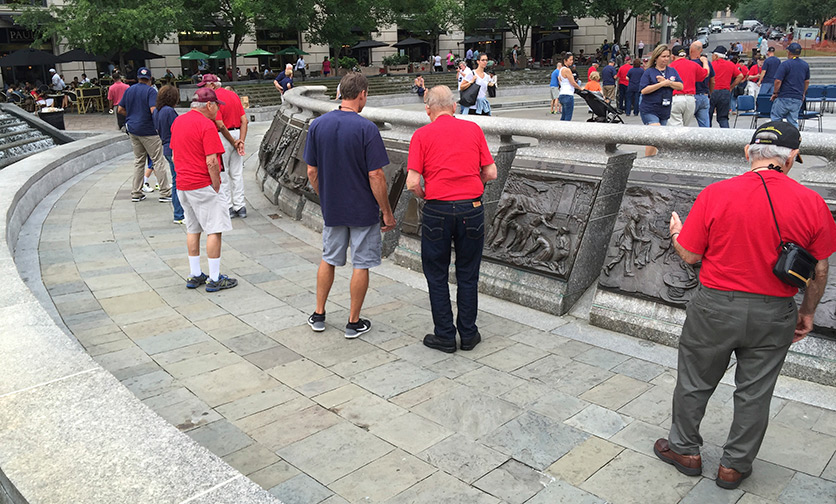
Left wall of bronze plaques
This particular memorial was a little disappointing at first. There didn’t seem to be a central focus in the center of the installation – not quite as uplifting as the others. There are tall masts with signal flags, but nothing central. To be sure, the amazing 3D bronze plaque sculptures surrounding the center were brilliant in their depth and creativity. They were the stars of the show and we spent all our time marveling at the artistry. Each plaque had a maritime story to tell going all the way back to the Monitor and the Merrimack to the Normandy Landing to the Apollo sea recovery mission. The Statue of the Lone Sailor is a larger than life sculpture that was surely intended to invite photo ops – which we were happy to oblige. The sound of the elevated semi-circular ponds and fountains create the feeling of a being immersed around a waterfall. The ground level center of the installation is an impressive “Granite Sea” map of the world.
It would be a good place to come to and relax in this busy urban environment.
We went to the other monuments on our schedule that day – the Korean War and Vietnam War Memorials. Both were as different as they could possibly be, but these two seemed to be the most somber of the day. We also toured the Smithsonian Air and Space and could have spent a whole day. It was absolutely spectacular. But those descriptions will wait for another day.
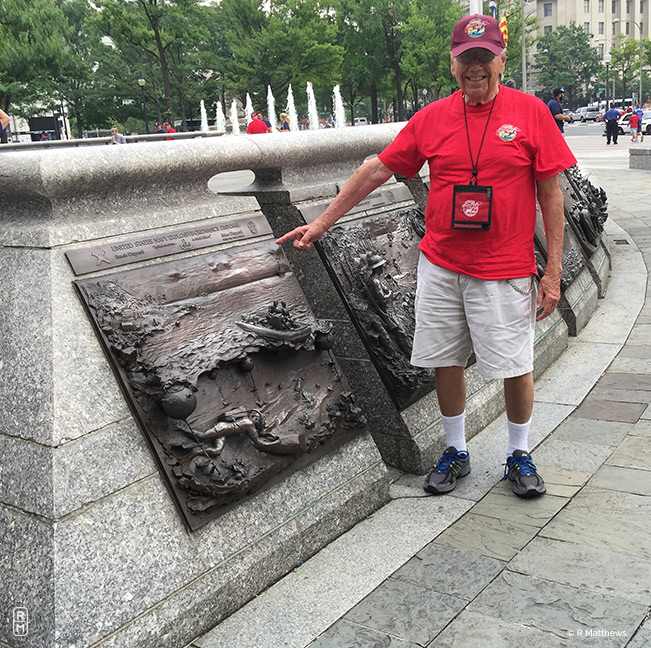
US Navy Explosive Ordinance Disposal – “Initial Success or Total Failure” – Dad’s department
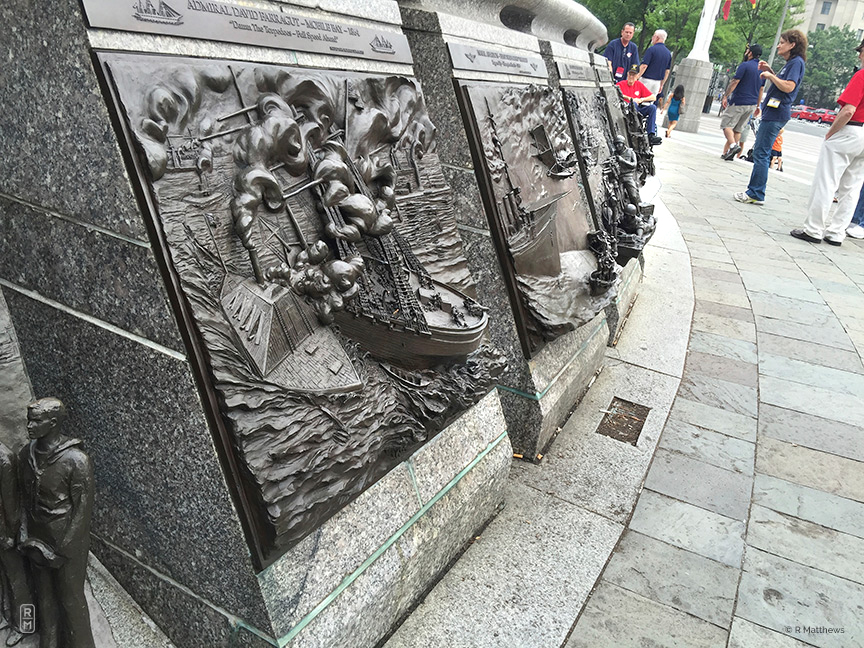
Admiral David Farragut – “Damn the Torpedoes – Full Speed Ahead”
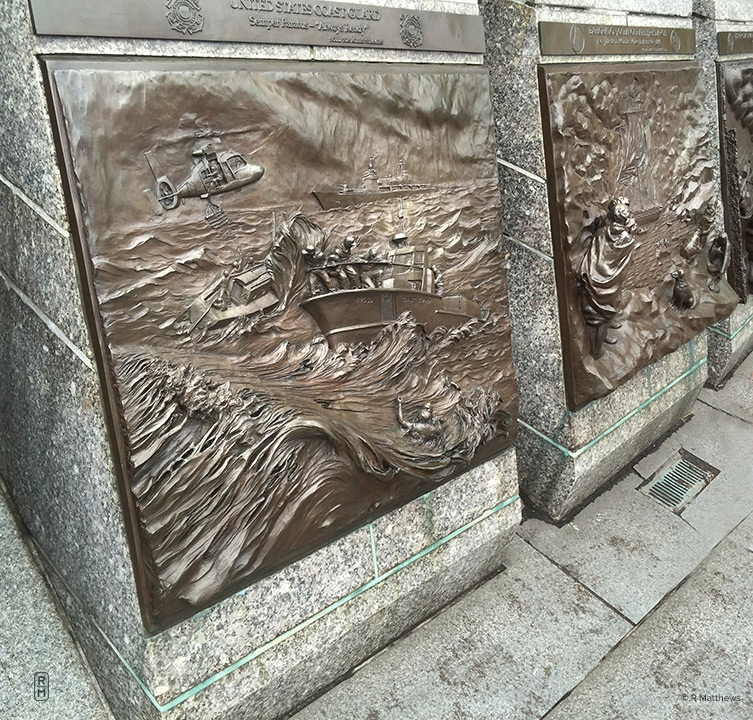
Semper Paratus – “Always Ready” Coast Guard.
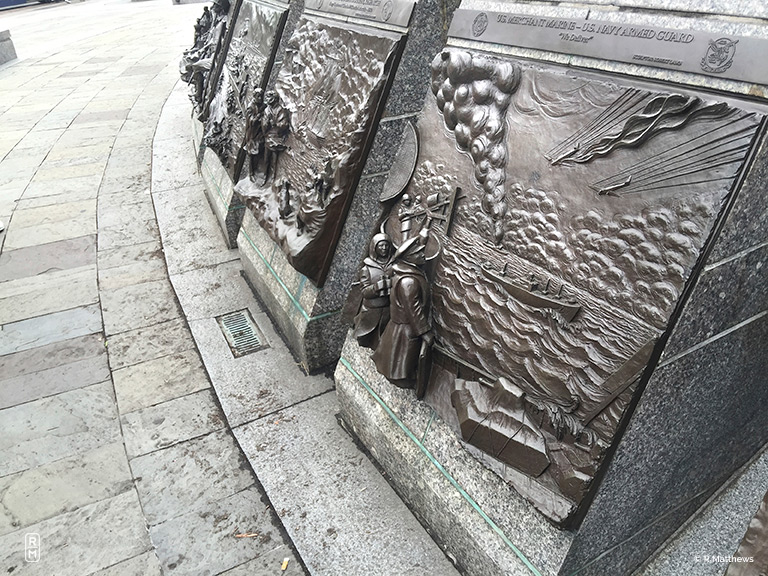
US Merchant Marines – “We Deliver”
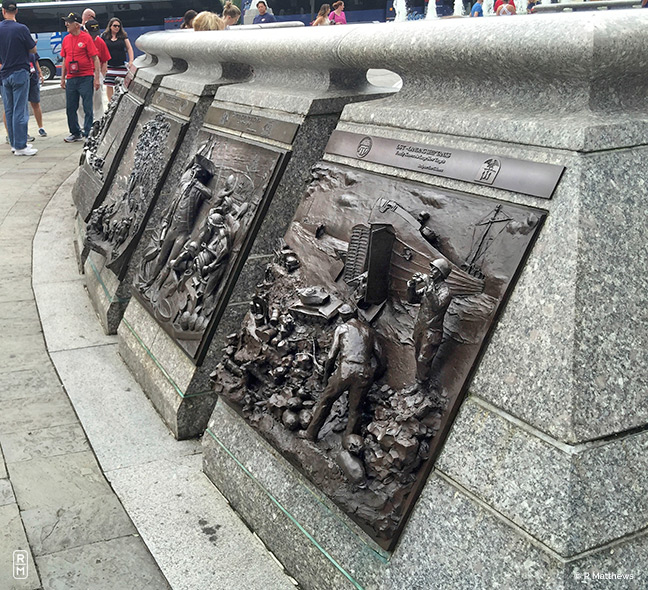
LST – Landing Ship Tanks
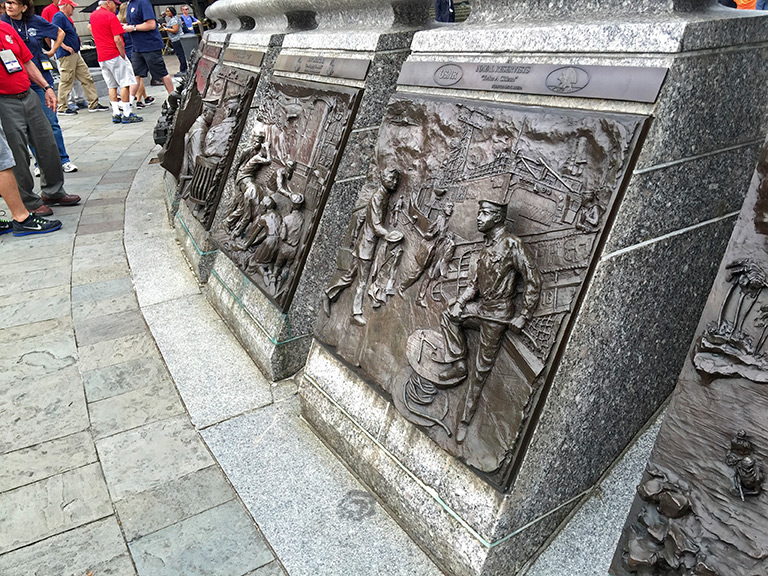
Naval Reservists – “Twice a Citizen”
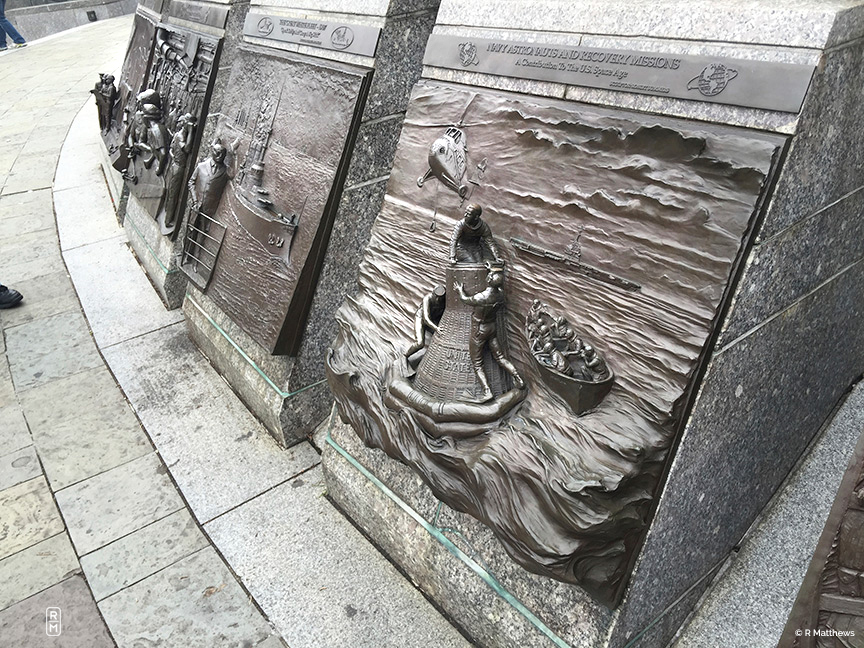
Navy Astronauts and Recovery Missions
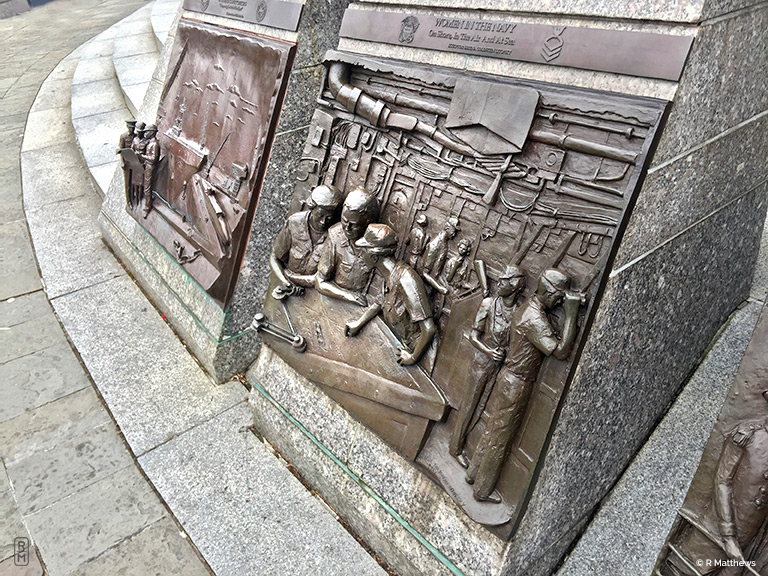
Women in the Navy – “On Shore, In the Air and at Sea”
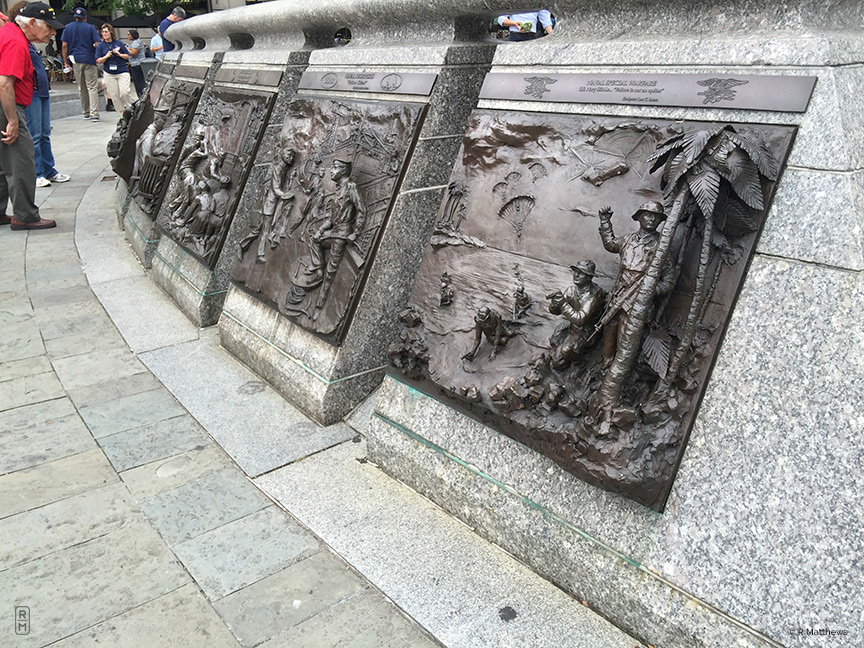
Naval Special Warfare. US Navy Seals – “Failure is Not an Option
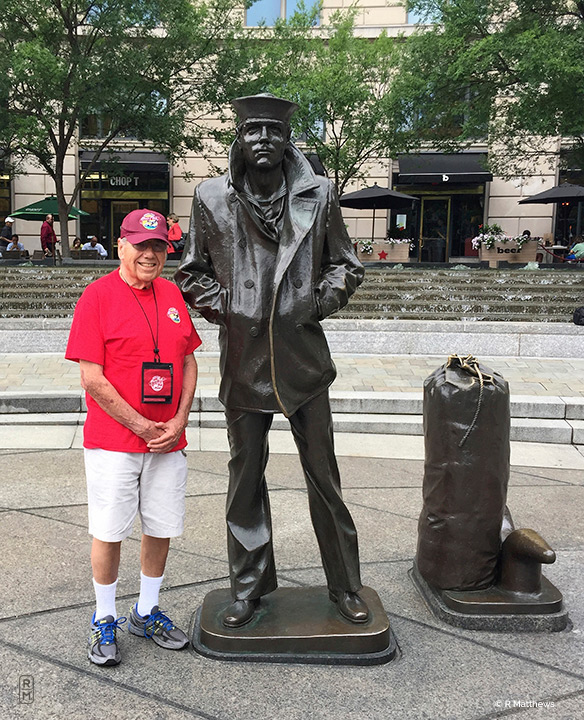
Robert “Bud” Matthews and The Lone Sailor
The trip to Washington DC was a lifetime experience and if you know any veteran you think might be interested check the Honor Flights in your region. The vets on the tour were truly blown away with the sites and experiences this ‘Greatest Generation’ we honor.
For Dad and I, check out the reception we got at the Fresno Airport when we arrived. Unbelievable!
